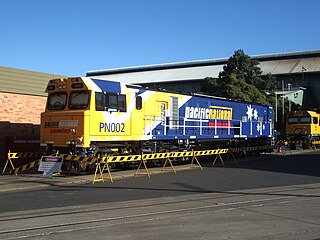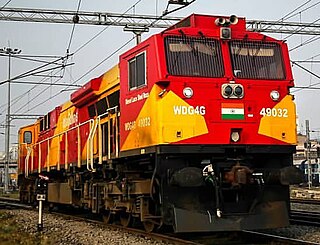
A locomotive or engine is a rail transport vehicle that provides the motive power for a train. If a locomotive is capable of carrying a payload, it is usually rather referred to as a multiple unit, motor coach, railcar or power car;

A diesel locomotive is a type of railway locomotive in which the power source is a diesel engine. Several types of diesel locomotives have been developed, differing mainly in the means by which mechanical power is conveyed to the driving wheels. The most common are diesel-electric locomotives and diesel-hydraulic.

An electric locomotive is a locomotive powered by electricity from overhead lines, a third rail or on-board energy storage such as a battery or a supercapacitor. Locomotives with on-board fuelled prime movers, such as diesel engines or gas turbines, are classed as diesel-electric or gas turbine-electric and not as electric locomotives, because the electric generator/motor combination serves only as a power transmission system.

Railway electrification is the use of electric power for the propulsion of rail transport. Electric railways use either electric locomotives, electric multiple units or both. Electricity is typically generated in large and relatively efficient generating stations, transmitted to the railway network and distributed to the trains. Some electric railways have their own dedicated generating stations and transmission lines, but most purchase power from an electric utility. The railway usually provides its own distribution lines, switches, and transformers.

A traction motor is an electric motor used for propulsion of a vehicle, such as locomotives, electric or hydrogen vehicles, or electric multiple unit trains.

The Evolution Series is a line of diesel locomotives built by GE Transportation Systems, initially designed to meet the U.S. EPA's Tier 2 locomotive emissions standards that took effect in 2005. The first pre-production units were built in 2003. Evolution Series locomotives are equipped with either AC or DC traction motors, depending on the customer's preference. All are powered by the GE GEVO engine.

An electro-diesel locomotive is a type of locomotive that can be powered either from an electricity supply or by using the onboard diesel engine. For the most part, these locomotives are built to serve regional, niche markets with a very specific purpose.
B-B and Bo-Bo are the Association of American Railroads (AAR) and British classifications of wheel arrangement for railway locomotives with four axles in two individual bogies. They are equivalent to the B′B′ and Bo′Bo′ classifications in the UIC system. The arrangement of two, two-axled, bogies is a common wheel arrangement for modern electric and diesel locomotives.

Alstom Traxx is a modular product platform of mainline diesel-electric and electric locomotives. It was produced originally by Bombardier Transportation and later Alstom, and was built in both freight and passenger variants. The first version was a dual-voltage AC locomotive built for German railways from the year 2000. Later types included DC versions, as well as quadruple-voltage machines, able to operate on most European electrification schemes: 1.5/3.0 kV DC and 15/25 kV AC. The family was expanded in 2006 to include diesel-powered versions. Elements common to all variants include steel bodyshells, two bogies with two powered axles each, three-phase asynchronous induction motors, cooling exhausts on the roof edges, and wheel disc brakes.
A hybrid train is a locomotive, railcar or train that uses an onboard rechargeable energy storage system (RESS), placed between the power source and the traction transmission system connected to the wheels. Since most diesel locomotives are diesel-electric, they have all the components of a series hybrid transmission except the storage battery, making this a relatively simple prospect.

The EMD G12 is a class of export locomotive built by GM-EMD, and its Canadian affiliate General Motors Diesel. In addition, Australian licensee Clyde Engineering built ten locomotives for New Zealand in 1957, five for Hong Kong, 23 for Queensland, fourteen for Western Australia and seven for BHP. Australian licensee Commonwealth Engineering also built 42 for Queensland Rail in 1964–66. Many examples were built in the 1950-1960s for railroads around the world.
Railway electric traction describes the various types of locomotive and multiple units that are used on electrification systems around the world.

Turkey has a state-owned railway system built to standard gauge which falls under the remit of the Ministry of Transportation and Infrastructure. The primary rail carrier is the Türkiye Cumhuriyeti Devlet Demiryolları (TCDD) which is responsible for all long-distance and cross-border freight and passenger trains. A number of other companies operate suburban passenger trains in urban conurbations.

The GT46C-ACe is a model of Australian diesel-electric locomotive designed and built between 2007–present by Downer Rail at its Cardiff Locomotive Workshops using Electro-Motive Diesel components until 2014, later units were built in Muncie, Indiana.

Railway electrification in Iran describes the past and present electrification systems used to supply traction current to rail transport in Iran with a chronological record of development, a list of lines using each system, and a history and a technical description of each system.

The GT42CU AC is a model of diesel electric locomotives manufactured by EDi Rail, Maryborough between 1999 and 2005 under licence from Electro-Motive Diesel, for use on narrow gauge railways in Queensland.

The GE PowerHaul is a class of mainline diesel-electric locomotives designed by General Electric. Thirty locomotives were ordered by Freightliner in 2007; the first locomotive was completed in July 2009 at GE's Erie, Pennsylvania, plant.
The Railway Institute is a research institute located in Warsaw, Poland.

The Indian locomotive class WDG-4G is a class of dual-cabin freight-hauling diesel-electric locomotive used by the Indian Railways (IR). The locomotive is designed by GE Transportation and is based on its Evolution Series, which are used in North America. The class is meant for freight hauling and replaces the older American Locomotive Company (ALCO)-designed locomotives, which have been the mainstay diesels of Indian Railways since 1962. Equipped with a 12-cylinder fully turbocharged GEVO engine, it is claimed to be 50% more environmentally friendly than its predecessors and is the first in the country to be compliant with level one of the emission norms set by the International Union of Railways (UIC-1). The locomotive has two cabs for easy reversal, both of which are air conditioned.

The Indian locomotive class WAG-4 is a class of 25 kV AC electric locomotives that was manufactured by CLW in the late 1960s for Indian Railways. The model name stands for broad gauge (W), AC Current (A), Goods traffic (G) engine, 1st (1). A total of 186 WAG-4 locomotives were built by The European Group 50 Hz Group/European Group/50 Cycles Group (consortium) between 1967 and 1969. They entered service in 1967.















